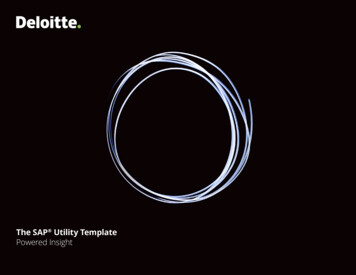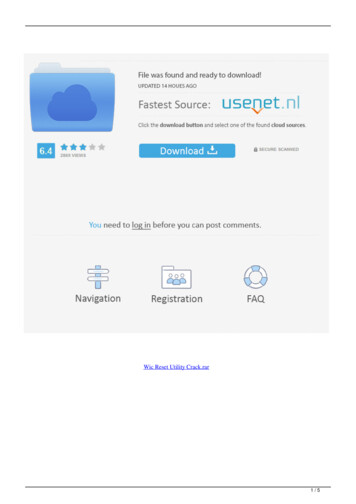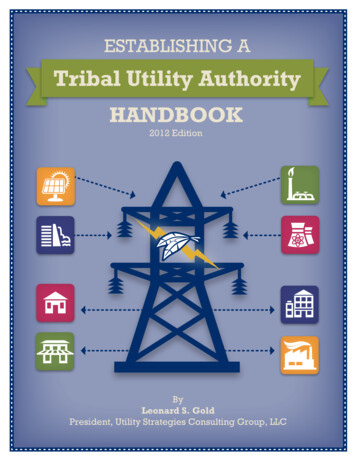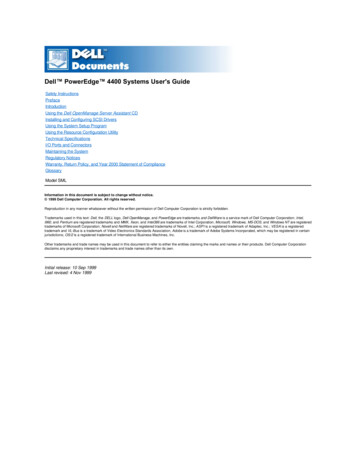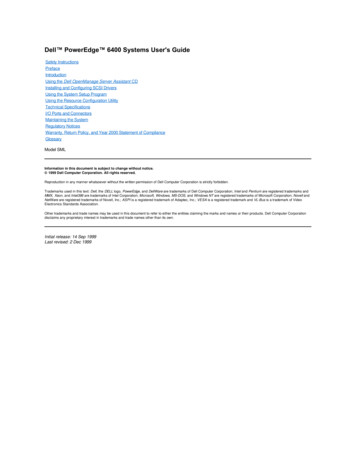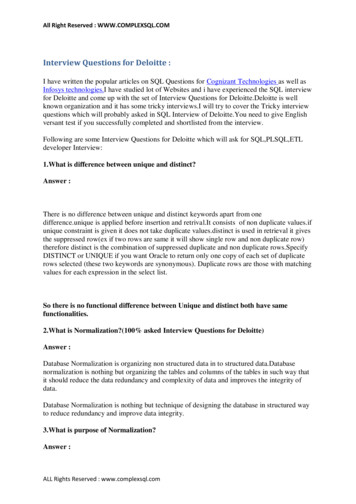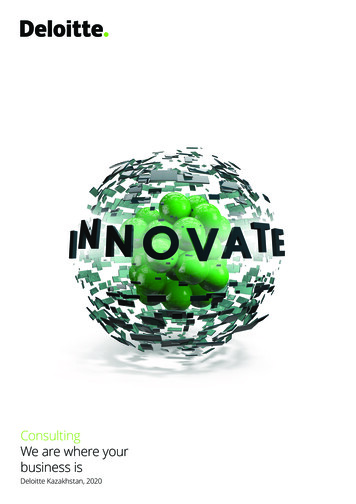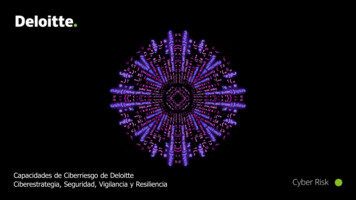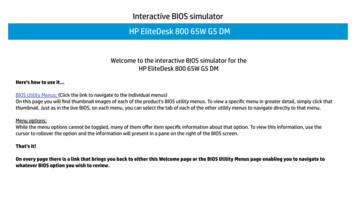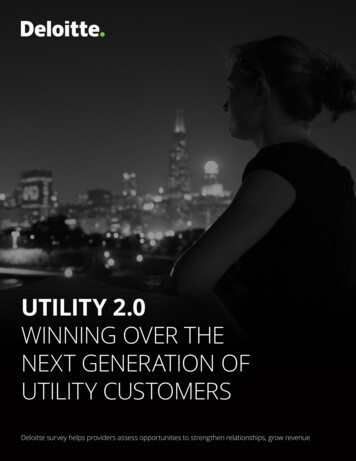
Transcription
UTILITY 2.0WINNING OVER THENEXT GENERATION OFUTILITY CUSTOMERSDeloitte survey helps providers assess opportunities to strengthen relationships, grow revenue
Brochure / report title goes here Section title goes here Utility 2.0 Winning over the next generation of utility customersEXECUTIVE SUMMARYExecutive summary03Introduction05Survey findings07Suggested next steps18Conclusion21Contacts22The Power & Utilities (P&U)industry is on the cusp oftransformation driven bytechnological advances,decreasing energy intensity,heightened environmentalawareness, and evolvingcustomer expectations.Although the P&U businessmodel has remainedrelatively unchanged overthe past century, traditionalelectricity, natural gas,and water utility providersare not exempt from thegrowing influence of thesetransformational forces.Historically, residential and commercial energy consumers expected their utilitycompanies to provide a reliable, affordable, unidirectional flow of electricityand information. Increasingly, however, consumers are demanding moreenvironmentally conscious energy options, two-way communication, andtransactive platforms that offer an interoperable, distributed energy frameworkversus the established hierarchical grid structure. To win over these savvy andengaged P&U consumers, utility providers will need to assess opportunities andchallenges in the critical areas of new products and services, communicationplatforms and practices, and overall customer satisfaction.In early 2017, Deloitte and YouGov America conducted the 2017 NextGeneration Power & Utilities Customer Survey with residential and medium/small commercial utility customers, as well as a small number of utility providers,to help P&U executives better understand customer expectations now andin the near-term future that may influence investment and strategy decisions.Surprisingly, there is significant customer interest in broader options andservices from their trusted utility service providers. Our survey findings reveal amix of positive news and areas for improvement: Counter to providers’ perception, customer satisfaction levels are high,attributable primarily to service reliability and low prices.1 Energy and utility consumers are motivated by environmental concernsand the desire to reduce costs. They are cutting their energy and waterconsumption, leading to stagnant demand growth for the first time inthe industry’s history. Clear opportunities exist to offset the decreasingconsumption by offering new energy efficiency (EE), distributed energyresources (DER), and analytics products and services that consumers areinterested in. Utility providers are not in sync with their customers’ needs and expectations,which services to offer, and how to communicate their value. Competitorsmay look to take advantage of a “participation gap” among customers that areinterested in new EE and DER products/services, but are not participating—inpart, because utility providers are not offering such solutions or encouragingcustomer involvement. Consumers are increasingly likely to take part in a transactive platformlike microgeneration or community solar. They see their utility providersas trusted advisors to help them make the shift towards a two-way flow ofenergy and information.023
Utility 2.0 Winning over the next generation of utility customers Residential and commercial consumers are interested in dynamic, twoway communication with their utility providers. This includes continuingpersonalized conversations with customer sales representatives (CSRs) whendesired, as well as expanded options such as website and automated selfservice.Utility 2.0 Winning over the next generation of utility customersINTRODUCTION Utility providers have brand permission to offer additional products,and collaborating with EE and DER companies could increase customerparticipation in new product/solution offerings.2General consensus is that utility providers will be well-served by directing futureinvestments towards becoming more customer-centric in the product/servicesand communication platforms they offer. Providers should consider a number ofsmart next steps to help grow revenues and strengthen customer relationships: Acknowledge and identify the differences in product, service, andcommunication preferences between residential and commercial customersegments, as well as differences within these segments. Use segment differences to advance a customized mix of products, services,and omni-channel communication strategies for each audience. Experiment with highly targeted pilot programs for new transactive platforms. Consider new pricing strategies including segment-specific products andservices bundling. Partner within and outside the P&U industry to help meet evolving customerexpectations, especially the desire for energy-efficient products and services. Use partnering and acquisitions to develop and launch new transactive energyprograms. Invest in integrating customer service and communications channels tostrengthen the provider-customer relationship. Consider adopting a SmartContact approach that aligns operations with the changing nature of customerinteractions, driven by new technology and the behaviors of the connectedconsumer.3Exponential growth intechnological capabilitiesand evolving customerexpectations lie at theheart of a fundamentalchange taking place in therelationship between Power& Utilities (P&U) providersand consumers.Traditionally, electric, natural gas, and water utility companies supplied reliable,affordable, one-way power/water flows to customers who typically were satisfiedhearing as little as possible from their provider. However, an increasing focuson energy efficiency (EE) and self-service, the growth of distributed energyresources (DER), and the spread of sensors, smartphones and other technologyadvancements are making consumers more aware of their energy usage andgiving them the ability to control it remotely. Additionally, innovations in solar andwind energy are making the self-generation of electricity an increasingly viableoption for many customers.In addition to, and enabled by new technologies, P&U customer expectationsare evolving, which is disrupting the traditional P&U business model and newproduct/service development. Residential and commercial consumers wantmore access to information, personalized service, and opportunities to minimizetheir environmental impact. For example, 73 percent of commercial customerssay they are very or extremely interested in energy management analytics, and52 percent of residential customers are very or extremely interested in rebatesfor EE appliances. As digitally-enabled, behind-the-meter energy generation andefficiency increasingly impact utility operations, the communication platformsavailable to next-gen consumers will assume added importance.These changes are taking place amidst a challenging economic climate in whichload growth is flattening. Faced with maintaining high fixed costs, utility providersmust look for new opportunities to raise revenues and become more efficient.The general consensus is that utility providers will be well-served by directingfuture investments towards becoming more customer-centric in the services andcommunication platforms they offer. This thesis is further supported by the 2017Deloitte Center for Energy Solutions paper Choose, Aggregate, Transact, whichhighlights increasing demand for renewables, aggregation services and access totransactive energy platforms.Investment activity varies across P&U segments. Electric utilities appear to havemade more forward-looking, customer-centric investments than gas and waterutilities, as evidenced by offering a wider range of customer communicationplatforms.4 One reason for this difference could be gas and water utilities’ lowerservice variability and the impact of end-user technologies. Another possiblereason: Investment does not necessarily align with consumers’ interests. Forexample, 25 percent of providers surveyed in 2017 express interest in investingin wind and solar generation, compared to residential interest in these servicesof 35 percent and commercial interest of 74 percent.45
Utility 2.0 Winning over the next generation of utility customersAs another example, providers may overestimate consumer interest in smarthome technology: 75 percent report plans to invest, while just 33 percent ofresidential customers are currently interested in the service.In addition to re-assessing investment opportunities, P&U providers shouldconsider how to implement new product and service offerings using updatedcustomer segmentation models and pricing strategies. For instance, as found inthe Deloitte Resources 2017 Study, millennials express preferences that differfrom their older counterparts in terms of environmental activism, bundling, andcommunication preferences.To help utility company executives plan their investment and productdevelopment decisions, Deloitte and YouGov America conducted the 2017 NextGeneration Power & Utilities Customer Survey in early 2017. The survey wasfocused on the following areas:Customer satisfaction Are customers satisfied with their utility provider’s offerings? Are there differences between residential and commercial customers?Communication platformsUtility 2.0 Winning over the next generation of utility customersABOUT THIS STUDYIn January 2017, Deloitte and YouGov Americaconducted an online survey of residential andcommercial utility customers to understand theirrelationship with their utility providers. Deloittealso collected observations from a small numberof utility providers to assess the areas of customersatisfaction, communication platforms, and newproducts and services.Survey of residential and commercialutility customers Nationally representative US survey Residential: 1504 customers with primaryor shared decision makers for utilities forthe household Commercial: 304 business decision-makerswith primary or shared responsibility for energymanagement for their company How do customers want to communicate with their utility providers(electric, gas, water)? Online surveys completed January 2017 Are utility providers providing the means of communications desiredby their customers?SURVEY DESIGNComponentsNew products and services What products and services are utility customers interested in? Are utilityproviders providing the services asked for by their customers? Who do customers trust to advise them and install the next generation ofproducts and services? Do all customers want to embrace the shift from ratepayer to prosumer?Our survey’s purpose was to enhance the conversation about customersatisfaction in the P&U industry so that electricity, natural gas, and water utilityproviders can develop solutions, generally enabled by digital technologies, thatbridge product/service and communication gaps, and better meet the needsand expectations of next-generation utility consumers. This paper shares majorsurvey findings, explains implications for utility providers, and offers suggestednext steps to grow revenues and strengthen customer relationships.6ResidentialCommercialNumber ofrespondents1504304Number ofdemographicquestions21Number ofsatisfactionquestions518Number ofcommunicationplatform questions1416Number of newproducts andservices questions202320SURVEY FINDINGSTo meet the emerging andevolving needs of theirresidential and commercialcustomers, utility companiesshould begin by workingto understand what isdriving consumers’ needs,expectations, and interests.According to our research, next-generation energy customers differ in their energypractices and preferences. A lot of consumers are content with the traditional,affordable, reliable power model; however, growing numbers of consumers Have higher expectations:–– Consumers want their provider transactions to be easy, informative, andoffer the opportunity to talk with someone when they so desire.–– Although primarily motivated by price and the desire to reduce costs,energy consumers also are motivated by environmental concerns. They areconsuming less electricity, leading to stagnant load growth for the first timein the industry’s history. To raise revenues, utility providers will need to offernew products and services.–– Consumers express interest in EE programs, better information, andanalytics to help monitor and manage usage, access to clean energy withinthe existing supply mix or through microgeneration and aggregated DERs.However, there is a disconnect between consumers’ stated interest andactual participation in EE programs and DER. Express interest in dynamic, two-way communication with providers:–– Residential and commercial consumers are interested in using variouschannels to communicate with their utility provider across different stages inthe customer lifecycle. Are increasingly likely to take part in a transactive platform like microgenerationor community solar:–– Consumers see their utility providers as trusted advisors; this provides anopportunity for companies to help consumers make the shift towards a twoway flow of energy and information.–– As digitally-enabled, behind-the-meter energy generation increasinglyimpacts utility company operations, effective two-way communication withcustomers will assume added importance.Our survey findings also reveal that, while residential and commercialutility customers and utility providers have some overlapping interests andexpectations (e.g., lowering costs and increasing energy efficiency), others aresegment-specific—and so are the product development and communicationimplications for utility companies.7
Utility 2.0 Winning over the next generation of utility customersUtility 2.0 Winning over the next generation of utility customersKey findingsNatural gas utility satisfaction Is highly satisfied with their utility providers (Figure 1) overall. Seventy-sixpercen
Invest in integrating customer service and communications channels to strengthen the provider-customer relationship. Consider adopting a Smart Contact approach that aligns operations with the changing nature of customer interactions, driven by new technology and the behaviors of the connected consumer.3 Exponential growth in technological capabilities . and evolving customer expectations .

